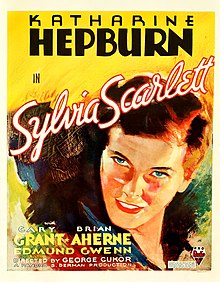| Sylvia Scarlett | |
|---|---|
 Theatrical release poster | |
| Directed by | George Cukor |
| Screenplay by | Gladys Unger John Collier Mortimer Offner |
| Based on | The Early Life and Adventures of Sylvia Scarlett 1918 novel by Compton MacKenzie |
| Produced by | Pandro S. Berman |
| Starring | Katharine Hepburn Cary Grant Edmund Gwenn Brian Aherne Natalie Paley |
| Cinematography | Joseph H. August |
| Edited by | Jane Loring |
| Music by | Roy Webb |
| Distributed by | RKO Radio Pictures |
Release date |
|
Running time | 90 minutes |
| Country | United States |
| Language | English |
| Budget | $641,000[1] |
| Box office | $497,000[1] |
Sylvia Scarlett is a 1935 American romantic comedy film starring Katharine Hepburn and Cary Grant, based on The Early Life and Adventures of Sylvia Scarlett, a 1918 novel by Compton MacKenzie. Directed by George Cukor, it was notorious as one of the most famous unsuccessful movies of the 1930s. Hepburn plays the title role of Sylvia Scarlett, a female con artist masquerading as a boy to escape the police. The success of the subterfuge is in large part due to the transformation of Hepburn by RKO makeup artist Mel Berns.
This film was the first pairing of Grant and Hepburn, who later starred together in Bringing Up Baby (1938), Holiday (1938), and The Philadelphia Story (1940).
Grant's performance as a dashing rogue sees him incorporate a Cockney accent and remains widely considered the first time Grant's famous personality began to register on film. (Grant used the Cockney accent in only a few other films, notably 1939's Gunga Din, 1943's Mr. Lucky and Clifford Odets's None but the Lonely Heart in 1944.) Cockney was not, however, Cary Grant's original accent. He was born and grew up in Bristol, which has a very different accent from that of London, where he only spent part of two years in his mid-teens working with a Vaudeville troupe. In the U.S., by sixteen, he began to attempt to sound more American to broaden the range of theatre roles for which he could be cast a decade before he ever appeared in a Hollywood "talkie".